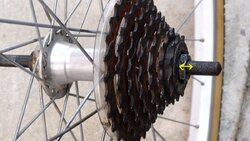woodbine
Senior Member
- Location
- Bristol, UK
I have an old 18 speed MTB with 6 speed Uniglide hub on the rear and Deore SIS shifters. The axle is threaded with securing nuts, not quick release.
Recently my bike went in to a shop for work inc. overhaul and service of rear hub. When it came back it seemed OK, but after a couple of weeks I noticed that the bearings in the rear hub and tightened of their own accord and the wheel didn't spin completely freely. I hadn't ridden the bike in this time, but had done a few small jobs on it which would not have caused this in any way. Poss the shop hadn't tightened the cone locknuts properly.
Anyway, I took the wheel off and returned it to the shop to correct the bearing tension/adjustment. When I got it back and went to put it in the rear drop-outs, I noticed that the spacing of the cones/locknuts on the axle was slightly wider than it had been before which meant the locknuts didn't quite fit between the drop-outs. I had to put slight outward pressure on the drop-outs to make the axle drop in between the frame drop-outs.
My questions;
Was it the right thing to put slight outward pressure on the drop-outs to widen the gap between them to allow the hub to drop in? Should I have taken the wheel back again and asked them to reduce the distance from the outer face of one locknut to the other locknut? If, because the spacing is now slightly different, and the cassette may sit a few mms in or out so that the distance between it and the derailleur is slightly altered - will this affect shifting up and down the cassette?
Basically, if the locknut were to be positioned slightly further in or out on axle ( see yellow arrow) when the shop adjusted it, this would make the cassette sit slightly closer or further away from the derailleur. Will this affect shifting? Or could this slight possible change to positioning be adjusted out?
(Photo isn't my bike)

Recently my bike went in to a shop for work inc. overhaul and service of rear hub. When it came back it seemed OK, but after a couple of weeks I noticed that the bearings in the rear hub and tightened of their own accord and the wheel didn't spin completely freely. I hadn't ridden the bike in this time, but had done a few small jobs on it which would not have caused this in any way. Poss the shop hadn't tightened the cone locknuts properly.
Anyway, I took the wheel off and returned it to the shop to correct the bearing tension/adjustment. When I got it back and went to put it in the rear drop-outs, I noticed that the spacing of the cones/locknuts on the axle was slightly wider than it had been before which meant the locknuts didn't quite fit between the drop-outs. I had to put slight outward pressure on the drop-outs to make the axle drop in between the frame drop-outs.
My questions;
Was it the right thing to put slight outward pressure on the drop-outs to widen the gap between them to allow the hub to drop in? Should I have taken the wheel back again and asked them to reduce the distance from the outer face of one locknut to the other locknut? If, because the spacing is now slightly different, and the cassette may sit a few mms in or out so that the distance between it and the derailleur is slightly altered - will this affect shifting up and down the cassette?
Basically, if the locknut were to be positioned slightly further in or out on axle ( see yellow arrow) when the shop adjusted it, this would make the cassette sit slightly closer or further away from the derailleur. Will this affect shifting? Or could this slight possible change to positioning be adjusted out?
(Photo isn't my bike)
Attachments
Last edited:

